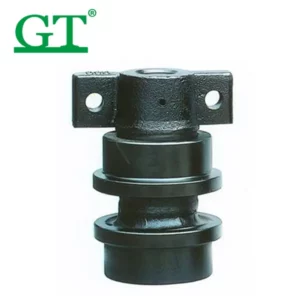Addressing noise emissions in excavator carrier roller design involves implementing various design and engineering strategies to minimize or mitigate unwanted sound.
Here are several approaches to address noise issues in carrier roller design:
- Material Selection:
- Choose materials with good damping properties to reduce vibrations that contribute to noise.
- Opt for materials that minimize frictional noise during contact with other components.
- Surface Finishes:
- Utilize surface coatings or treatments that reduce friction and noise during the rotation of the carrier roller.
- Implement precision machining to achieve smooth and even surfaces, minimizing irregularities that can contribute to noise.
- Bearing Selection:
- Use high-quality, well-lubricated bearings with noise-reducing features to minimize rotational noise.
- Consider sealed or shielded bearings to prevent contaminants from entering and causing additional noise.
- Design for Balanced Loads:
- Ensure that the load on the carrier roller is evenly distributed to prevent uneven wear and noise generation.
- Implement design features that promote balanced loading, such as proper alignment and sizing.
- Vibration Isolation:
- Integrate vibration isolation mechanisms to dampen vibrations that can lead to noise emissions.
- Consider the use of elastomeric materials or isolators to absorb and dissipate vibrations.
- Precision Engineering:
- Employ precision engineering techniques to ensure tight tolerances and minimize clearance, China excavator carrier roller for sale reducing the potential for noise-causing vibrations.
- Structural Integrity:
- Design carrier rollers with structural integrity to prevent flexing or deformation that may lead to noise during operation.
- Use robust construction methods to enhance the overall stability and durability of the carrier roller.
- Lubrication and Maintenance:
- Implement effective lubrication systems to reduce friction and wear, which can contribute to noise.
- Establish regular maintenance schedules to address wear issues promptly and prevent the escalation of noise problems.
- Noise Damping Materials:
- Integrate noise-absorbing or damping materials within the carrier roller design to mitigate sound transmission.
- Consider the use of rubber or other damping materials in areas where metal-to-metal contact occurs.
- Computer-Aided Simulation:
- Utilize computer-aided design (CAD) and simulation tools to model the carrier roller’s behavior under different operating conditions.
- Identify potential sources of noise and iteratively refine the design to minimize these issues.
- Testing and Validation:
- Conduct rigorous testing under real-world operating conditions to identify and address any unexpected noise issues.
- Use testing data to validate the effectiveness of design modifications and improvements.
By incorporating these strategies into the carrier roller design process, manufacturers can work towards reducing noise emissions, enhancing the overall performance of the excavator, and improving the operator’s working environment.
